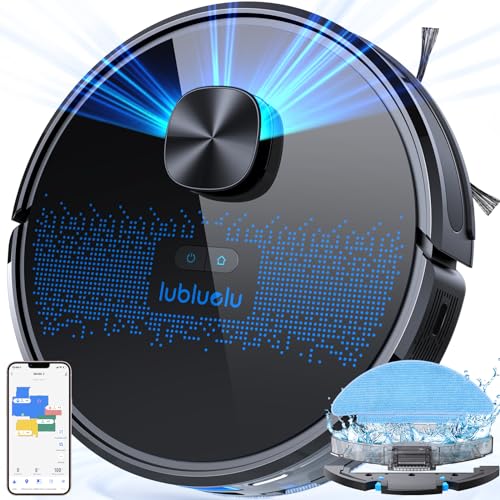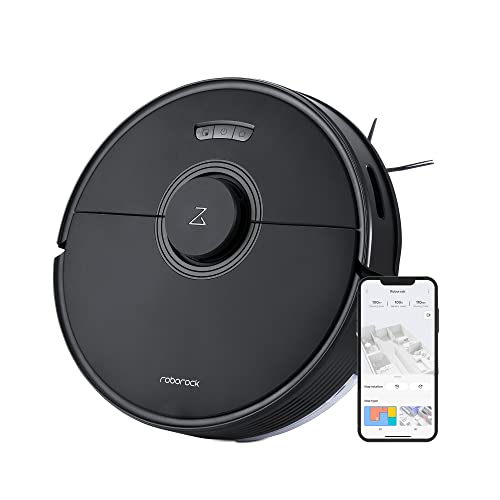Five Killer Quora Answers On Lidar Vacuum Robot
페이지 정보

본문
Lidar Navigation for Robot Vacuums
 A robot vacuum will help keep your home clean without the need for manual involvement. A robot vacuum with advanced navigation features is essential for a hassle-free cleaning experience.
A robot vacuum will help keep your home clean without the need for manual involvement. A robot vacuum with advanced navigation features is essential for a hassle-free cleaning experience.
Lidar mapping is an essential feature that helps robots navigate easily. Lidar is a tried and tested technology developed by aerospace companies and self-driving vehicles for measuring distances and creating precise maps.
Object Detection
To allow robots to be able to navigate and clean a house it must be able to recognize obstacles in its path. In contrast to traditional obstacle avoidance techniques, which use mechanical sensors to physically contact objects to identify them, lidar robot navigation that is based on lasers provides a precise map of the environment by emitting a series laser beams and measuring the amount of time it takes for them to bounce off and return to the sensor.
The data is then used to calculate distance, which allows the robot to build a real-time 3D map of its surroundings and avoid obstacles. Lidar mapping robots are much more efficient than any other method of navigation.
For example the ECOVACST10+ comes with lidar technology that scans its surroundings to identify obstacles and map routes according to the obstacles. This will result in more efficient cleaning since the robot will be less likely to become stuck on chair legs or under furniture. This will save you money on repairs and fees and allow you to have more time to complete other chores around the home.
Lidar technology is also more efficient than other navigation systems used in robot vacuum cleaners. Binocular vision systems are able to provide more advanced features, including depth of field, than monocular vision systems.
A higher number of 3D points per second allows the sensor to produce more precise maps quicker than other methods. Combining this with less power consumption makes it much easier for robots to run between charges, and extends their battery life.
Finally, the ability to recognize even negative obstacles such as holes and curbs could be essential for certain types of environments, like outdoor spaces. Some robots, such as the Dreame F9, have 14 infrared sensors to detect the presence of these types of obstacles and the robot will stop automatically when it senses an impending collision. It will then choose an alternate route and continue cleaning when it is diverted away from the obstruction.
Real-time maps
Lidar maps provide a detailed overview of the movement and condition of equipment on the scale of a huge. These maps can be used for a range of applications such as tracking the location of children to simplifying business logistics. Accurate time-tracking maps have become essential for many business and individuals in the age of connectivity and information technology.
Lidar is a sensor that sends laser beams and records the time it takes for them to bounce off surfaces before returning to the sensor. This information allows the robot to accurately measure distances and make a map of the environment. This technology is a game changer in smart vacuum cleaners, as it allows for more precise mapping that can be able to avoid obstacles and provide complete coverage even in dark areas.
A lidar-equipped robot vacuum can detect objects that are smaller than 2mm. This is in contrast to 'bump and run' models, which use visual information for mapping the space. It can also detect objects that aren't evident, such as remotes or cables, and plan an efficient route around them, even in dim conditions. It also can detect furniture collisions and choose efficient routes around them. Additionally, it can make use of the app's No Go Zone feature to create and save virtual walls. This prevents the robot from accidentally removing areas you don't would like to.
The DEEBOT T20 OMNI uses an ultra-high-performance dToF laser with a 73-degree horizontal as well as a 20-degree vertical field of view (FoV). The vacuum covers a larger area with greater effectiveness and precision than other models. It also prevents collisions with furniture and objects. The vac's FoV is large enough to allow it to operate in dark environments and provide superior nighttime suction.
The scan data is processed using an Lidar-based local map and stabilization algorithm (LOAM). This produces a map of the surrounding environment. It combines a pose estimation and an algorithm for detecting objects to calculate the position and orientation of the robot with lidar. It then employs a voxel filter to downsample raw points into cubes that have the same size. The voxel filter can be adjusted to ensure that the desired number of points is attainable in the filtered data.
Distance Measurement
lidar navigation robot vacuum uses lasers, just as sonar and radar use radio waves and sound to analyze and measure the environment. It is often utilized in self-driving cars to navigate, avoid obstacles and provide real-time maps. It is also being used in robot vacuums to improve navigation and allow them to navigate over obstacles on the floor more efficiently.
lidar vacuum cleaner operates by generating a series of laser pulses which bounce back off objects before returning to the sensor. The sensor records the duration of each return pulse and calculates the distance between the sensors and nearby objects to create a virtual 3D map of the environment. This enables robots to avoid collisions and to work more efficiently around toys, furniture, and other items.
While cameras can be used to measure the surroundings, they don't provide the same level of precision and effectiveness as Lidar Vacuum robot. A camera is also susceptible to interference caused by external factors like sunlight and glare.
A LiDAR-powered robotics system can be used to quickly and precisely scan the entire space of your home, identifying every object that is within its range. This gives the robot to choose the most efficient route to take and ensures that it can reach all corners of your home without repeating.
LiDAR can also detect objects that are not visible by a camera. This is the case for objects that are too tall or that are hidden by other objects like a curtain. It can also identify the difference between a chair leg and a door handle, and even differentiate between two items that look similar, such as pots and pans or books.
There are many different types of LiDAR sensors available on the market. They vary in frequency and range (maximum distant), resolution and field-of-view. Many leading manufacturers offer ROS ready sensors that can easily be integrated into the Robot Operating System (ROS) as a set of tools and libraries that are designed to simplify the creation of robot software. This makes it simple to create a strong and complex robot that can be used on many platforms.
Error Correction
The capabilities of navigation and mapping of a robot vacuum depend on lidar sensors for detecting obstacles. However, a range of factors can interfere with the accuracy of the mapping and navigation system. For example, if the laser beams bounce off transparent surfaces such as glass or mirrors, they can confuse the sensor. This can cause robots to move around these objects without being able to detect them. This can damage both the furniture as well as the robot.
Manufacturers are working to address these issues by implementing a new mapping and navigation algorithms which uses lidar data combination with other sensor. This allows the robot to navigate a space more efficiently and avoid collisions with obstacles. Additionally, they are improving the sensitivity and accuracy of the sensors themselves. The latest sensors, for instance can recognize smaller objects and those that are lower. This can prevent the robot from ignoring areas of dirt and debris.
Lidar is distinct from cameras, which can provide visual information, since it uses laser beams to bounce off objects before returning to the sensor. The time taken for the laser beam to return to the sensor gives the distance between the objects in a room. This information can be used to map, detect objects and avoid collisions. Lidar also measures the dimensions of the room which is useful in planning and executing cleaning paths.
Hackers could exploit this technology, which is good for robot vacuums. Researchers from the University of Maryland demonstrated how to hack into a robot vacuum's LiDAR with an Acoustic attack. Hackers can detect and decode private conversations of the robot vacuum by analyzing the sound signals that the sensor generates. This could allow them to steal credit cards or other personal information.
 Check the sensor often for foreign matter such as hairs or dust. This could hinder the view and cause the sensor not to turn correctly. This can be fixed by gently turning the sensor by hand, or cleaning it using a microfiber cloth. Alternatively, you can replace the sensor with a new one if you need to.
Check the sensor often for foreign matter such as hairs or dust. This could hinder the view and cause the sensor not to turn correctly. This can be fixed by gently turning the sensor by hand, or cleaning it using a microfiber cloth. Alternatively, you can replace the sensor with a new one if you need to.
 A robot vacuum will help keep your home clean without the need for manual involvement. A robot vacuum with advanced navigation features is essential for a hassle-free cleaning experience.
A robot vacuum will help keep your home clean without the need for manual involvement. A robot vacuum with advanced navigation features is essential for a hassle-free cleaning experience.Lidar mapping is an essential feature that helps robots navigate easily. Lidar is a tried and tested technology developed by aerospace companies and self-driving vehicles for measuring distances and creating precise maps.
Object Detection
To allow robots to be able to navigate and clean a house it must be able to recognize obstacles in its path. In contrast to traditional obstacle avoidance techniques, which use mechanical sensors to physically contact objects to identify them, lidar robot navigation that is based on lasers provides a precise map of the environment by emitting a series laser beams and measuring the amount of time it takes for them to bounce off and return to the sensor.
The data is then used to calculate distance, which allows the robot to build a real-time 3D map of its surroundings and avoid obstacles. Lidar mapping robots are much more efficient than any other method of navigation.
For example the ECOVACST10+ comes with lidar technology that scans its surroundings to identify obstacles and map routes according to the obstacles. This will result in more efficient cleaning since the robot will be less likely to become stuck on chair legs or under furniture. This will save you money on repairs and fees and allow you to have more time to complete other chores around the home.
Lidar technology is also more efficient than other navigation systems used in robot vacuum cleaners. Binocular vision systems are able to provide more advanced features, including depth of field, than monocular vision systems.
A higher number of 3D points per second allows the sensor to produce more precise maps quicker than other methods. Combining this with less power consumption makes it much easier for robots to run between charges, and extends their battery life.
Finally, the ability to recognize even negative obstacles such as holes and curbs could be essential for certain types of environments, like outdoor spaces. Some robots, such as the Dreame F9, have 14 infrared sensors to detect the presence of these types of obstacles and the robot will stop automatically when it senses an impending collision. It will then choose an alternate route and continue cleaning when it is diverted away from the obstruction.
Real-time maps
Lidar maps provide a detailed overview of the movement and condition of equipment on the scale of a huge. These maps can be used for a range of applications such as tracking the location of children to simplifying business logistics. Accurate time-tracking maps have become essential for many business and individuals in the age of connectivity and information technology.
Lidar is a sensor that sends laser beams and records the time it takes for them to bounce off surfaces before returning to the sensor. This information allows the robot to accurately measure distances and make a map of the environment. This technology is a game changer in smart vacuum cleaners, as it allows for more precise mapping that can be able to avoid obstacles and provide complete coverage even in dark areas.
A lidar-equipped robot vacuum can detect objects that are smaller than 2mm. This is in contrast to 'bump and run' models, which use visual information for mapping the space. It can also detect objects that aren't evident, such as remotes or cables, and plan an efficient route around them, even in dim conditions. It also can detect furniture collisions and choose efficient routes around them. Additionally, it can make use of the app's No Go Zone feature to create and save virtual walls. This prevents the robot from accidentally removing areas you don't would like to.
The DEEBOT T20 OMNI uses an ultra-high-performance dToF laser with a 73-degree horizontal as well as a 20-degree vertical field of view (FoV). The vacuum covers a larger area with greater effectiveness and precision than other models. It also prevents collisions with furniture and objects. The vac's FoV is large enough to allow it to operate in dark environments and provide superior nighttime suction.
The scan data is processed using an Lidar-based local map and stabilization algorithm (LOAM). This produces a map of the surrounding environment. It combines a pose estimation and an algorithm for detecting objects to calculate the position and orientation of the robot with lidar. It then employs a voxel filter to downsample raw points into cubes that have the same size. The voxel filter can be adjusted to ensure that the desired number of points is attainable in the filtered data.
Distance Measurement
lidar navigation robot vacuum uses lasers, just as sonar and radar use radio waves and sound to analyze and measure the environment. It is often utilized in self-driving cars to navigate, avoid obstacles and provide real-time maps. It is also being used in robot vacuums to improve navigation and allow them to navigate over obstacles on the floor more efficiently.
lidar vacuum cleaner operates by generating a series of laser pulses which bounce back off objects before returning to the sensor. The sensor records the duration of each return pulse and calculates the distance between the sensors and nearby objects to create a virtual 3D map of the environment. This enables robots to avoid collisions and to work more efficiently around toys, furniture, and other items.
While cameras can be used to measure the surroundings, they don't provide the same level of precision and effectiveness as Lidar Vacuum robot. A camera is also susceptible to interference caused by external factors like sunlight and glare.
A LiDAR-powered robotics system can be used to quickly and precisely scan the entire space of your home, identifying every object that is within its range. This gives the robot to choose the most efficient route to take and ensures that it can reach all corners of your home without repeating.
LiDAR can also detect objects that are not visible by a camera. This is the case for objects that are too tall or that are hidden by other objects like a curtain. It can also identify the difference between a chair leg and a door handle, and even differentiate between two items that look similar, such as pots and pans or books.
There are many different types of LiDAR sensors available on the market. They vary in frequency and range (maximum distant), resolution and field-of-view. Many leading manufacturers offer ROS ready sensors that can easily be integrated into the Robot Operating System (ROS) as a set of tools and libraries that are designed to simplify the creation of robot software. This makes it simple to create a strong and complex robot that can be used on many platforms.
Error Correction
The capabilities of navigation and mapping of a robot vacuum depend on lidar sensors for detecting obstacles. However, a range of factors can interfere with the accuracy of the mapping and navigation system. For example, if the laser beams bounce off transparent surfaces such as glass or mirrors, they can confuse the sensor. This can cause robots to move around these objects without being able to detect them. This can damage both the furniture as well as the robot.
Manufacturers are working to address these issues by implementing a new mapping and navigation algorithms which uses lidar data combination with other sensor. This allows the robot to navigate a space more efficiently and avoid collisions with obstacles. Additionally, they are improving the sensitivity and accuracy of the sensors themselves. The latest sensors, for instance can recognize smaller objects and those that are lower. This can prevent the robot from ignoring areas of dirt and debris.
Lidar is distinct from cameras, which can provide visual information, since it uses laser beams to bounce off objects before returning to the sensor. The time taken for the laser beam to return to the sensor gives the distance between the objects in a room. This information can be used to map, detect objects and avoid collisions. Lidar also measures the dimensions of the room which is useful in planning and executing cleaning paths.
Hackers could exploit this technology, which is good for robot vacuums. Researchers from the University of Maryland demonstrated how to hack into a robot vacuum's LiDAR with an Acoustic attack. Hackers can detect and decode private conversations of the robot vacuum by analyzing the sound signals that the sensor generates. This could allow them to steal credit cards or other personal information.
 Check the sensor often for foreign matter such as hairs or dust. This could hinder the view and cause the sensor not to turn correctly. This can be fixed by gently turning the sensor by hand, or cleaning it using a microfiber cloth. Alternatively, you can replace the sensor with a new one if you need to.
Check the sensor often for foreign matter such as hairs or dust. This could hinder the view and cause the sensor not to turn correctly. This can be fixed by gently turning the sensor by hand, or cleaning it using a microfiber cloth. Alternatively, you can replace the sensor with a new one if you need to.- 이전글What's The Current Job Market For Sleeping Couch And Sofa Professionals Like? 24.08.25
- 다음글10 Unquestionable Reasons People Hate Crate And Barrel Sleeper Sofa 24.08.25
댓글목록
등록된 댓글이 없습니다.








